Part 2: Geophysical, Geodetic Alignments
Ask anyone about the Egyptian pyramids and most people will tell you that the pyramids were built as tombs for the ancient Egyptian Pharaohs. After all, that's what we were taught in school and far too many of us have accepted that explanation and have not concerned ourselves to think about the subject again.
The pyramids of Giza may indeed have been used as tombs, but what we are now going to reveal, provides proof that the Great Pyramid and the other pyramids at Giza were not designed nor built for the sole purpose of being mere burial mounds for a few vainglorious Pharaohs. Under the tremendous weight of numerous contradicting factors, this explanation remains wanting and many are now challenging this view.
The scientific knowledge incorporated in the Great Pyramid is startling in its complexity: that the basic shape of a pyramid could contain many different disciplines of knowledge is truly mind-boggling.
Many have said or indeed have discovered for themselves that the Great Pyramid is a mathematical compendium incorporating all kinds of astronomical and cosmological formulas.
Although mainstream Egyptologists and historians tend to ignore many of these factual findings and conclusions, and if pressed would answer with the words, "coincidence" or "fortuitous", we are told that the overall dimensions of the Great Pyramid incorporate measurements from which the Earth's size and shape can be calculated, as well as the distance between the Earth and the moon and the distance between the Earth and the sun.
It has also been established that the Great Pyramid is a scale model of the northern hemisphere of the Earth, incorporating the geographical degrees of both latitude and longitude and that the distance between the location of the Great Pyramid and the North Pole is the same distance between the surface of the Earth and its core-Center.
As we will now reveal, the Great Pyramid is also a miniature model of the whole Earth; its angle geometry incorporating a picture/diagram of the Earth's orbital dynamics and the obliquity of its axis, and that furthermore this picture is both determined and confirmed by the fact that the location of the Great Pyramid on the Earth is also incorporated within its geometry as a reference.
'If one is to send a message the prime requirement is of course that people will read it, it is no good putting it in a bottle, throwing it in the ocean and then hoping it will be found. One must place the message somewhere where it simply cannot be missed, a place so significant that its very location makes a notable statement in itself'.
An apt observation as we will see.
It appears that the location of the Great Pyramid is indeed a 'statement in itself', perhaps giving us the first clue that this impressive man-made structure contains comparative data pertaining to the obliquity (tilt) of the Earth's polar axis – and for good reason.
The Location of the Great Pyramid
Perhaps the first interesting thing that one discovers about the Great Pyramid is that it is perfectly oriented to the four points of the compass – only being out by 3 arc minutes – a discrepancy of less than 0.06 percent.
We are told that the most accurate north-oriented structure today is the Paris Observatory – however, even this is 6 arc minutes off from true north.
Like a huge sundial, the sharp pointed shadows cast by the Great Pyramid from the sun's position in the sky, will naturally mark the annual dates of the summer and winter Solstices as well as the vernal (spring) and autumnal Equinoxes.
The annual seasons result from the fact that the Earth is tilted some 23.5 degrees in respect of the plane of the Earth's orbit around the sun – known as the Plane of the Ecliptic.
The '23.5º' value is popularly used as a general figure. At present the exact figure for the obliquity (incline) of the axis is 23.44º – and in arc hours and minutes it is 23º 26'.
The Great Pyramid sits on the 30th parallel – almost 30 degrees, north latitude from the equator and just over 31°, east longitude from Greenwich.
Its location is actually 29º 58' 51" N in arc hours and minutes, and in degrees the location is 29.98º – just 2,125 metres short of exactly 30 degrees north latitude.
This relatively small discrepancy could be explained by the GP having been constructed on the closest suitable site to this 30ºN location and perhaps because it was built over an existing great mound or bedrock which was already worshipped as the 'primordial mound'.
Now the above is common knowledge, however, what many of us have neglected to realise is that as the Earth rotates daily on its oblique axis of 23.5 degrees, the Great Pyramid will move between two extremes – i.e., 36.5º from the North Pole of the Ecliptic and 53.5º from the ecliptic plane – to 60º from the North Pole of the Ecliptic and 6.5 degrees from the Ecliptic Plane.
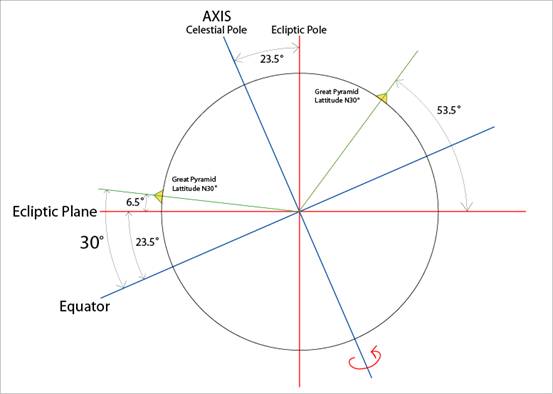
Figure 1: The Great Pyramid and its two extreme positions from the Ecliptic Plane with the daily rotation of the Earth – 6.5 degrees and 53.5 degrees.
So, the Great Pyramid having been built 30 degrees north of the Equator so that as the Earth turns it comes as close as 6.5 degrees to the ecliptic, is in itself a significant statement which is pointing directly to the obliquity of the Earth's polar axis . . .
30º subtract 6.5º = 23.5º
It is indeed ironic that something as important as this is also something that is hardly ever mentioned in all the information given about the Great Pyramid.
This fact that the Great Pyramid comes as close as 6.5 degrees from the ecliptic plane has only been stated in one source as far as we are aware.
This is Ancient Freemasonry (1919) by Frank C. Higgins. However, Higgins appears to have overlooked the underlying importance of this fact: that along with the 30-degree location of the GP north of the Equator, its 6.5-degree position north of the Ecliptic points directly and mathematically to the angle of the Earth's axis.
As said, the location of the Great Pyramid is our first clue that the Great Pyramid contains information pertaining to the 23.5º obliquity of the Earth and perhaps for good reason.
The next step is where to look for this information in the Great Pyramid.
Three Points
If information about the obliquity of the Earth's axis exists within the GP, then what better way would there be to preserve this information than having it encoded within its geometry?
In Part One, we noted that the shafts and particularly their angles were of primary importance in the plan and construction of the Great Pyramid.
These angle differences can only mean that each shaft is pointing to a specific area of the sky and together they are telling us something.
Furthermore, the angles of the shafts and what they may be pointing at can only really be appreciated and studied properly by looking at a scale plan of the Great Pyramid in cross-section. So like the shafts, the information we are looking for would be presented in 'angle' form within the geometry of the GP – again shown in cross-section.
Our drawing is to scale and based on the accepted measurements as recorded by William Flinders Petrie during his survey of the Great Pyramid between 1880 and 1882. It has been established that the side angles of the GP are 51.84º.
Naturally, we would be looking for angles with the same geodetic/GP-locale-related values as we see in fig. 1 . . . 6.5º, 23.5º and 30º.
And to our surprise – because it is something so simple that has been completely overlooked – it doesn't take a great deal of searching, head scratching or fumbling around with a protractor to find these very same angles once we know what we are looking for. Indeed by examining our 'to-scale' cross-section drawing, we find that the most specific 'key points' of the GP are actually connected by these same angles.
We will begin with a simple drawing of the GP so as to delineate the key points we will be using.
In cross-section, the pyramid becomes a triangle with only three points:
1). Apex
2). South Vertice
3). North Vertice
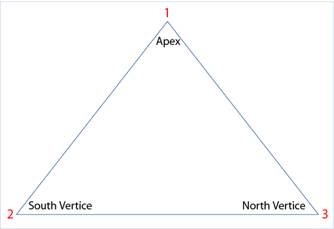
Figure 2 – Three Points
To demonstrate these findings we will now begin with the simple East-West cross-section diagram of the GP complete with shafts and their vertices as shown in Part One:
As revealed in Part One, we know that the King's Chamber shafts are offset from the Queen's Chamber shafts to the south by some 6.5 degrees and from the apex, and so it is from the apex that we will plot this same angle and towards the south.
Let's assume we don't know where this angle or line is going or indeed what it is pointing to.
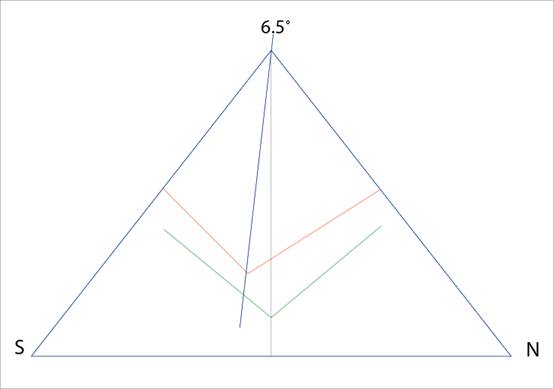
Figure 3 – The Great Pyramid in E-W cross-section showing the shafts. Via the Apex, the Vertice of the Upper Shafts is offset by 6.5º from the vertice of the Lower Shafts.
As we can see, and if we didn't know any better, plotting a line of 6.5º from the Apex – the first of our three points – and towards the south, already results in a significant alignment – in that this line closely intersects the vertice of the King's Chamber shafts.
Again, this alignment which illustrates that the upper shafts are offset by 6.5º from the apex as well as those of the lower shafts, further verifies the 'mean difference' of approximately 6.5 degrees in the angles of the upper and lower star shafts.
However, as we will see later, the angle of 6.5º has more significance in that it also relates to the location of the GP on the Earth – i.e., the GP coming as close as almost 6.5º from the Ecliptic.
Again, assuming that we don't know where it is going or what it is pointing to, we will now plot the angle of 23.5º from the second point – the south vertice.
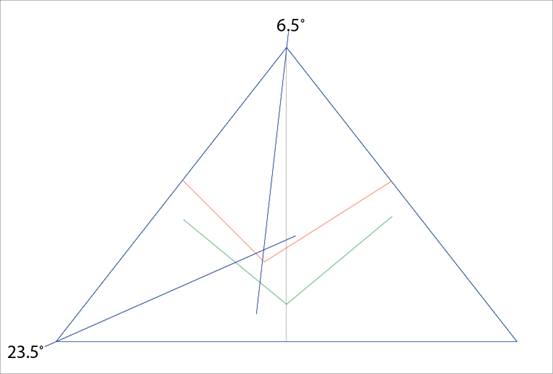
Figure 4 – The angle of 23.5º from the south vertice
Further confirmation that both these angles plotted from two of three points do indeed correlate with each other directly thereby confirming their meaningful, geodetic relationship with the GP and its location, is determined by the fact that both these angles intersect each other within half a degree of the point-centre of the King's Chamber (see Appendix, 'Precise Angles').
And in doing so and in respect of the enormous size of the GP, they give the height of the King's Chamber and its N-S position within the GP. (See Fig. 5).
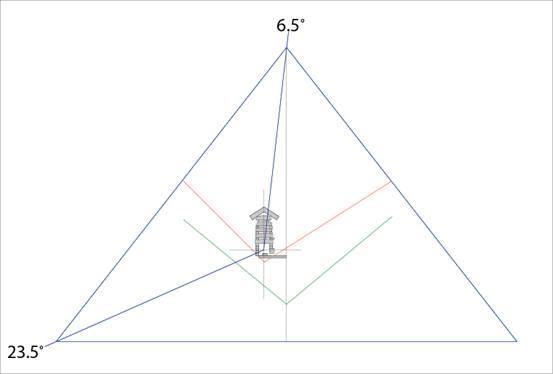
Figure 5 – The angles of 23.5º and 6.5º intersect the centre of the King's Chamber thereby giving its position within the GP
By chance these angles could have crossed each other anywhere within the vast internal dimension of the GP, but they intersect at the centre of the King's Chamber.
So far so good . . . but what about the 'third point' – the north vertice in our diagram of the GP in cross-section? Does this present anything of significant value?
There are only two main chambers we know of inside the Great Pyramid. One of these is the King's Chamber – the position of which has already been determined by the geodetic/GP-locale-related angles from the first two points.
The other is the Queen's Chamber.
The central axis of the GP actually runs through the centre of the Queen's Chamber as shown above by the vertice of its shafts and we know that the chamber is positioned just above this vertice.
Based on what we have already discovered with the King's Chamber, and again using our scale drawing, the next logical step would be to measure the angle beginning from the north vertice to the centre of the Queen's Chamber.
To fit the emerging picture and provide further evidence that will take us one more step beyond any notion or belief that this is all a coincidence, the angle that connects the north vertice with the centre of the Queen's Chamber, has to have a correlating, geodetic relationship with the other angles.
At this stage, this is a tall order . . .
As we can see, and even before we begin measuring the angle, whatever this angle is we know that it cannot be 23.5º, 6.5º or 30º.
In fact, one finds that this angle is very close to 11.75º. (11.73º to be precise – again, see Appendix.) For many of us, on first discovering this, the value would appear meaningless . . . until we realise that 11.75º is exactly half the angle of 23.5º.
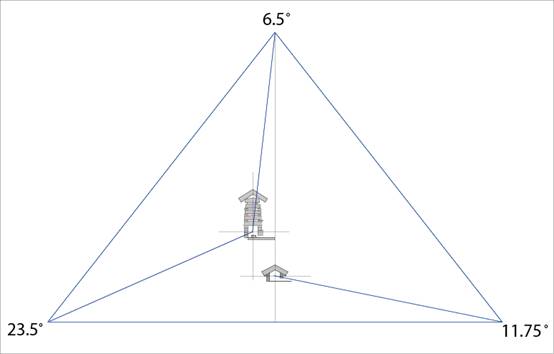
Figure 6 – The angle of 11.75 º intersects the centre of the Queen's Chamber thereby giving its position within the GP. (Shafts not included for clarity)
So, against all the odds – (if by any chance we could or would prefer to believe that the previous findings are a coincidence) – again we find that this angle from the north vertice to the centre of the QC is indeed compatible and consistent with the previous angles we have found, in that the values of these angles are the same as those with which we began with in fig. 1 . . . angles that are determined by the GP's location on the Earth.
Moreover, the centre of the Queen's Chamber is situated on the central axis of the GP and this means we can plot the same angle from the south vertice and obtain the same result.
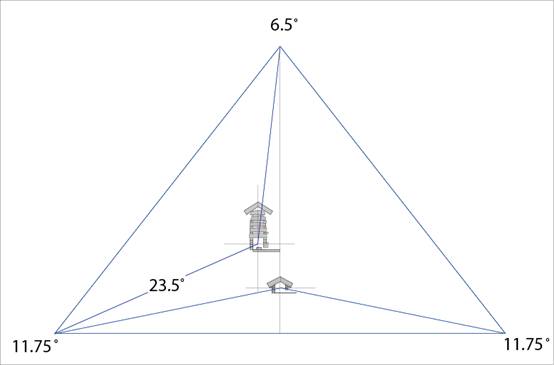
Figure 7 – Two angles of 11.75º intersecting the centre of the Queen's Chamber – both angles adding up to 23.5º
So in effect, these two angles of 11.75º that intersect the centre of the Queen's Chamber, add up to 23.5º – the same value as the angle intersecting the King's Chamber from the south vertice.
2 x 23.5º = 47º is meaningful and within context here, because 47º is the radius of the precessional circle traced in the sky over c. 25,920 years by the Earth's tilted axis.
Staying with the theme of Precession which is also associated with the obliquity of the Earth's axis, the angles of the sloping sides of the GP are 51.84º, and using the Platonic value for precession, the value 51,840 amounts to two precessional cycles of 25,920 years.
If this isn't a coincidence then we would have to ask why two precessional cycles? If intentional then perhaps this detail is part of the code we are unravelling here and something we have yet to decipher.
What if we now add the values of these four angles together?
11.75º + 11.75º + 23.5º + 6.5º = 53.5º
As said, as the Earth turns daily on its axis of 23.5º, the GP comes as close as 6.5º and as distant as 53.5º from the Ecliptic Plane (see Fig.1).
Again, what are the odds against this, if what we see here doesn't reflect any intent on behalf of the pyramid's architects?
But this is not all . . .
The next logical step would be to examine the angle between the two chambers. One would suspect that the angle would also be 23.5º and perpendicular with the 23.5º angle that intersects the King's Chamber.
At first, one is disappointed to find that the chambers are centred on an angle of precisely 26.77º – not 23.5º.
However, it's interesting that a line from the centre of the KC to the floor of the QC, intersecting the point where the floor and the central axis of the GP meet, is indeed 23.5º: and the thing that is so appealing about this alignment, is that the floor of the Queen's Chamber is level with the 23.5th Course Layer of the GP.
As many will know the core masonry of the Great Pyramid is now exposed due to its outer limestone casing having been removed centuries ago. The core masonry now consists of 203 steps or layers from the base to the truncated top of the pyramid.
So in effect, this 23.5º angle from the centre of the King's Chamber intersects a point (the centre of the green cross in Fig. 8) that is already marked-up to the value of 23.5.
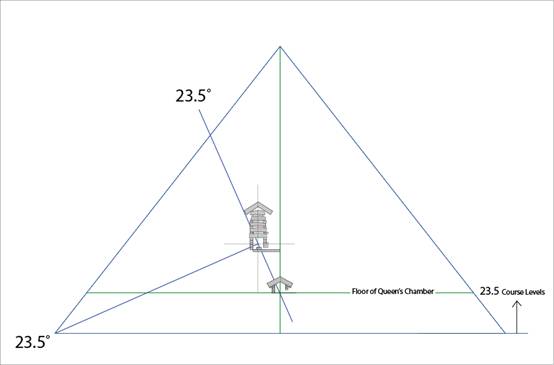
Figure 8 – The perpendicular angle of 23.5º that runs through the centre of the KC and the point where the centreline of the GP intersects the floor of the QC – the floor being level with the 23.5th Course Layer
It appears that the same number of Course Layers from the base of the GP to the floor of the Queen's Chamber was used by the architects to verify this angle and its alignment.
One could argue with this and ask why go to all this trouble? Why not centre the two chambers on an angle of 23.5 degrees if this was the original intention?
The simple answer is that for the architects this was impossible given the 51.84º angle of the sides, which appear to have been vital to the overall design.
If the architects had already determined the positions of both chambers via the 23.5º and 6.5º angles to the centre of the KC, and the two 11.75º angles that are half the 23.5º value for the QC, then it would have been impossible aligning the centres of both these chambers on a perpendicular 23.5º angle. The only way this would be possible was if the angles of the sides were 48.42º – a difference of 3.5º. This means that the side angles of 51.84º was of paramount importance.
The geophysical-associated message has already been made clear with the angles we have already discovered, and as we will see later, this perpendicular angle, although important, would have been considered secondary in the overall plan.
So to perhaps show that this alignment would have been ideal in practice and was originally intended for reasons which will soon be made clear, the next best thing was to make sure that the intersection point of both the centreline of the GP and the floor of the QC were connected to the centre of the KC by an angle of 23.5º, and that as an afterthought it was decided that the number of Course Layers from the base to the floor of the QC would both reflect and confirm the value of this intended angle.
This could be argued of course, but this is our explanation as to how the architects may have got around the problem of not being able to centre both chambers on a 23.5-degree angle in addition to the other alignments they had already made and on which the overall geometry of the GP depended.
In any case, there is a good reason why this perpendicular angle of 23.5º would have to exist and be present within these alignments, and this is because it completes the geophysical picture encoded within the geometry of the Great Pyramid, a picture we are yet to reveal.
But before we reveal this, let's look at another aspect of this perpendicular alignment . . .
If we now extend the lines of the cross on which the King's Chamber is centred (see Fig. 9, lines in red) to emphasise the 6.5-degree offset of the KC from the apex, we note that the perpendicular 23.5º angle and the 6.5º angle together present us with the 30º angle – signifying the latitude distance of the Great Pyramid from that of the Equator or Equatorial Plane.
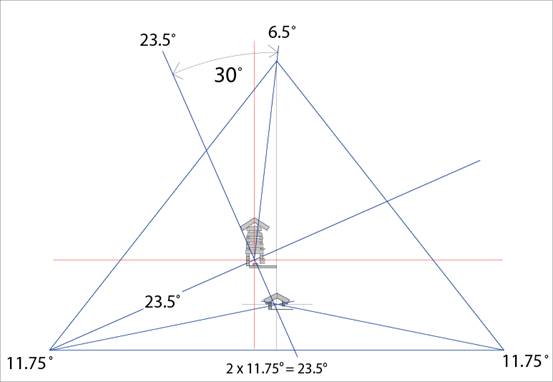
Figure 9 – The angle of 30 degrees
Of course the value 30º has always been there as it is also the sum value of the two angles that connect the apex and the south vertice to the centre of the King's Chamber.
"You can get any number out of the pyramid by choosing random points".
So said a sceptic in response to a public forum letter that included a brief introduction to this discovery, and we quote it here as a typical example of the "knee-jerk" reactions people make.
With due respect, this person clearly didn't understand the simplicity of what is being expressed here because as we can see, the four values with which we began and which we see illustrated in Fig. 1 – i.e., 30º, 23.5º, 6.5º, 53.5º – are all present within the geometry of the Great Pyramid and all from connecting just the three points and the two chambers we have to play with when viewing the GP in cross-section . . . just five points – and five significant points we might add.
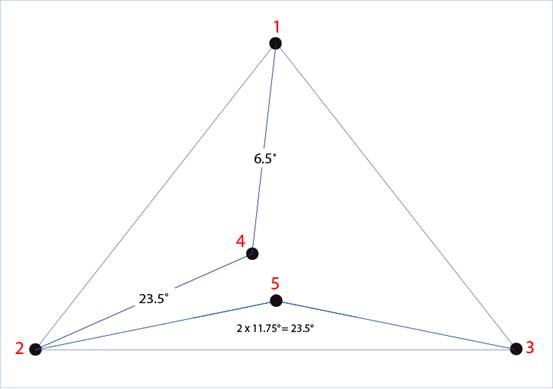
Figure 10 – Five Points
Not "random points" and not just "any number", and what's more these values correlate with the geophysical picture of the tilted Earth and also correlate with the GP's own position on the Earth and in relation, it being 30º from the Equator and 6.5º from the Ecliptic – again, 30º subtract 6.5º = 23.5º
Also, KC 23.5º add QC 23.5º = 47º (precession radius) add 6.5º = 53.5º.
Looking at this another way, it is a fact that with the Great Pyramid at 30ºN, the daily cycle of its 6.5º to53.5º distances from the Ecliptic Plane actually depends on the 23.5º obliquity of the polar axis. And it's precisely these values that we find in the angles between these five points and also in their sum total – 53.5º.
Angles and Course Levels
The reader may have been wondering about the angle between the north vertice and the centre of the King's Chamber and what value this angle might be?
Well we can reveal that the angle is 20º.
It appears that the number of Course Levels from the base of the GP to the floors of the chambers actually reflect the degree values of these angles, as revealed briefly in Fig 8, and as we will see, the addition of this particular angle presents further evidence for this:
South Vertice to centre of King's Chamber . . . 23.5º
Apex to Centre of King's Chamber . . . 6.5º
North Vertice to Centre of King's Chamber . . . 20º
Sum total . . . 50º.
We find that the floor of the King's Chamber is level with the 50th Course Layer.
South Vertice to Centre of Queen's Chamber . . . 11.75º
Apex to Centre of King's Chamber . . . 0º
North Vertice to Centre of Queen's Chamber . . . 11.75º
Sum total . . . 23.5º
We find that the floor of the Queen's Chamber is level with the 23.5th Course Layer.
See diagrams in Fig 11 below:
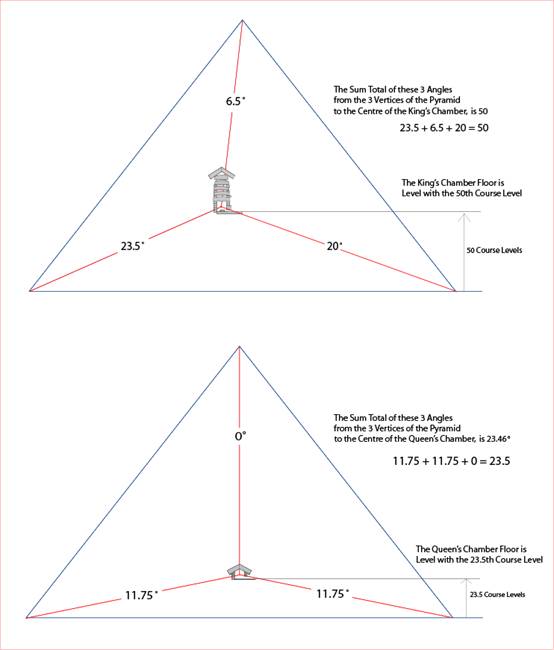
Figure 11 – The Degree Values of the Angles are Reflected in the Number of Course Layers
Note, that this leaves 26.5 courses between the floors of the QC and the KC.
50 – 23.5 = 26.5.
26.5º is the angle of both the Ascending and Descending Passages – 26.3º to be exact. We are now certain that the value of 26.5º is also part of the code associated with the tilt of the Earth's Axis and this is something we are yet to reveal.
Staying with the "random points" argument, and based on how we view things, one question that has been asked many times is this:
"Why anchor these angles to the abstract centres of the chambers? There is nothing substantial at the centres to use as a reference point, only empty space".
Well certainly the E/W cross-section image of the GP that many of us have become familiar with and which shows the planned internal features of the GP would have been one of the more important blueprints in the construction of the GP. And we should note that the 'intangible' point centres of the chambers would have also been included for positioning purposes – especially if a grid was employed in the overall plan.
The architects understood that to incorporate these geodetic angles in the geometry the angles from each of the three vertices would have to intersect at a central point. Aside from the 'point centre' of the pyramid, which would only express a limited number of values, the obvious choice would be two or three chambers; and aside from their practical positioning purposes, the point centres of the chambers would also be the most logical choice on which to anchor these angles because there are numerous physical features to choose from. Choosing any one of them would leave room for doubt, because there is always an element of uncertainty . . . as in "should they intersect somewhere on the sarcophagus?" . . . and . . . "what values would we get if we measure the angles from the three points to the corner of the 'Great Step'?"
We can see then that the otherwise 'intangible' centres of the chambers are the most logical choice one would make when measuring the angles from the three vertices of the GP. The centres of the chambers are simply the most central part of the chamber, and in finding that the values of these angles are consistent, in that together they present a geodetic picture of the earth in association with the GP's location, there is no room for doubt that the centres of the chambers is where the angles from the three vertices of the GP are supposed to intersect so as to present the picture we were supposed to see.
To see the beauty of all this it's time we revealed the hidden picture that is centred on the King's Chamber . . .
An Unknown Fact:
The Hidden Geodetic Picture Encoded
Within the Geometry of the Great Pyramid
Earlier we mentioned that there is a good reason why this perpendicular angle of 23.5º connecting both chambers would have to exist and be present within these alignments, and this is because this particular angle would represent the Equatorial Plane.
Taking our diagram of the tilted Earth with the location of the GP as shown in fig. 1, it is a fact that that we can superimpose our diagram of the Great Pyramid, complete with the angles we have found, over the diagram of the tilted Earth and find that everything aligns perfectly – the correct N-S orientation of the GP and these angles also being an important factor or dynamic.
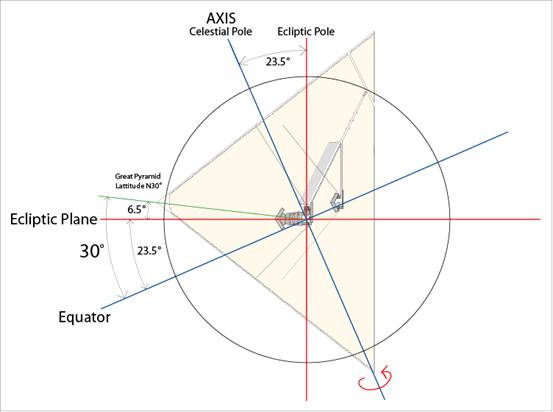
Figure 12 – The Great Pyramid superimposed over the Earth revealing the Geodetic Information hiding in plain sight within the Geometry of the Great Pyramid
The 23.5º angle that runs from the south vertice and through the centre of the KC represents the Earth's Celestial or Polar Axis.
We find that the extended red lines on which the King's Chamber is centred now represent the squared Ecliptic Plane and the Ecliptic Pole. Again the Earth is tilted 23.5-degrees in respect of the ecliptic.
Everything centres on the KC, which means that symbolically, the King's Chamber represents the core-centre of the Earth.
For many this is the most sacred chamber in the pyramid, so in terms of any religious, mystical or esoteric significance we may attribute to this particular chamber, could this chamber represent anything less?
This means that anyone making their way up the ascending passage and then climbing upwards through the Grand Gallery to enter this chamber is really making a symbolic journey to the centre of the Earth . . . the centre of our reality even.
But the most amazing feature in all of this is that the Great Pyramid is actually pointing to its own location on the Earth via its apex!
The apex which would represent the missing capstone is like a miniature Great Pyramid in this superimposed diagram (fig. 12) – poking out of the Earth where the Great Pyramid is located – again being 30º N of the Equator and coming as close as 6.5º to the Ecliptic.
To see this yourself, print an acetate (see through) image of any cross-section diagram of the Great Pyramid taken from the Internet – providing its features are dimensionally close to the original – and also scan and print an acetate 2-dimensional image of any text-book diagram of the Earth, tilted as it is from the Ecliptic.
Now taking the diagram of the Earth, draw a triangle to mark the GP's location on the Earth with a marker pen – it has to be 30º from the Equator and on an angle of 6.5º from the Ecliptic and on the side of the earth to which the axis is tilting.
You will find that when you superimpose the two diagrams together via the centre of the earth and the centre of the King's Chamber, the geodetic angles relating to the Earth in respect of its orbit around the sun and the angle geometry of the GP, will match perfectly (providing the sizes of the two images are relative to this match) and it's an amazing thing that they do because if this is by chance then the odds against this are enormous.
The Precession Radius
We find more information when we position the Earth so that the polar axis is upright:
We discover that in this position, the angle from the centre of the KC to the north vertice is between 46.5º and 47º. This is so close to the radius of the circle traced in the sky by the axis over the course of c. 25,920 years due to precession, that it's difficult to put aside as being a mere coincidence.
Again, the radius of the precessional circle is 47º – twice the angle of 23.5º.
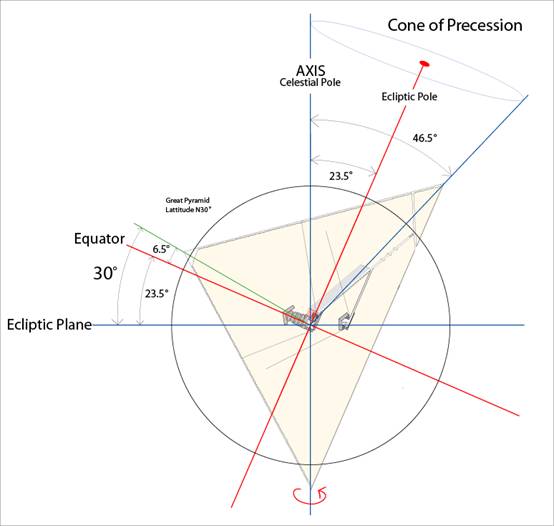
Figure 13 – The Axis positioned upright presenting an angle of between 46.5º and 47º from the centre of the KC to the north vertice, thereby revealing the 'Cone of Precession'
After everything else we have seen, this is an alignment that could only be expected as it completes the geophysical picture of the Earth and its orbital dynamics.
These angles by which just FIVE features or points are connected together within this E-W cross-section drawing of the Great Pyramid, is we feel, a simple and clever design conceptualised at the initial blueprint/planning phase of its construction.
The angles to and from these five points provide meaning – a geophysical-geodetic connection in relation to the location of the GP – and from the alignments they produce we can unearth all kinds of geophysical information.
After all, building a huge sphere to express the same geophysical information would have been impossible, but to express the same information mathematically in the form of angles, the abstract pyramid structure is perfect.
It could be said that what is being presented here within the geometry of the Great Pyramid is a simple factual reference; a record in stone pertaining to the geophysical condition of our planet – much like what we would find in any encyclopaedia. On one level this picture relates to all the other factual and referential planetary, orbital and cosmological data that others have found or have claimed to have found hidden within the measurements and dimensional geometry of the GP.
But we suspect this reference to the obliquity of the Earth's axis is more than that: that what we see here is merely the introduction to a code that contains further information we have yet to interpret.
Thinking logically, if what we see here was intended then this geophysical picture was merely meant to grab our attention at the outset – the addition of the GP's own location being a veritable factor and a key reference for these alignments
Again if intended then the only time in the future when it was hoped this initial part of the code would be, or could be deciphered, is when the readers of the code already know these geophysical facts; in that what we see in the GP can be recognised and compared to the facts we already know about our planet and are familiar with.
However, what would be the point of this encoded, geophysical picture for people who already know it?
From this, we can only deduce that there is a lot more to this code than we see here . . .
As revealed in Part One, the 6.5º 'mean difference' between the upper and lower sets of shafts, if targeting the same two stars at different times, appears to suggest an Earth axial shift of 6.5 degrees in remote antiquity. If so, then nonetheless, such a shift would have been catastrophic.
Evidence that this encoded information within the GP also points to a major axis shift in the past and possibly one or more in the near future, will be presented in a follow-up article.
Gary Osborn and Scott Creighton
September 2008.
Appendix:
Precise Angles
It's highly possible that the builders of the Great Pyramid were never as precise or as accurate as many of us would prefer to be or are capable of being today.
We like to be precise and it's only natural that we would prefer to know the exact values of these angles down to the nth degree; however, we are also aware that in being too precise, one can miss the point entirely.
Were the architects, or for that matter, the builders of the GP as precise as we are today? Were they concerned with fractions of a degree? Perhaps up to a certain point yes; but in being too precise we really don't want to overstep the whole thing and lose the simplicity of the meaning which we feel we were meant to comprehend here.
The following angle values based on Petrie's measurements of the Great Pyramid of Giza were calculated and kindly passed onto us by Spiros Boutsikos.
In his own words:
"Using Petrie's measures – that is mean height of KC, base height from ground level we compute that the middle of KC's height from ground level is:
[(1923.7"+1921.6")/2 + 1692.8"]/2 = 87.7005 rc
Now taking into account the exact width of KC and its distance from centre we compute the horizontal distance from the corner using the half base length:
115.182 m – 330.9" – (5.24 m/2) = 198.9414 rc
Thus the angle y is:
y = tan^1(87.7005/198.9414) = 23.7896 degrees
The KC center-GP apex angle based on Petrie measures is 6.242 degrees.
Now computing the mean height of Queen's chamber is tricky. We need to compute the cross section area and then equate it to a parallelogram with a width equal to the width of the same chamber. This is the volumetric center of the chamber (notice the top part is a triangle):
[184.47"+ (245.1"-184.47")/2]/2 + 834.4" = 45.6904 rc
Thus the angle t is:
t = tan^1(45.6904/220) = 11.7326 degrees.
2 x 11.7326 degrees = 23.4652 degrees."
Throughout the main text we have expressed the angle values of 23.5º . . . 6.5 º . . . and 30º.
These values are directly related to the recognised and established geophysical knowledge we have of the Earth today – i.e., the obliquity of its axis – and the location of the Great Pyramid which has a direct orientation relationship to this obliquity. Therefore these particular values are our 'touchstone' – our criterion. After all, it's through these angles and their values that one immediately recognises a geophysical connection here.
We are well aware that in using these particular values we also encounter a problem . . .
According to the Milankovitch theory, which has largely been accepted, the tilted axis slowly shifts between 22.1º and 24.5º and back again over a period of 41,000 years. It is said that the angle of the axis is now decreasing and at a rate of 1.19 metres per century.
Egyptologists say the Great Pyramid was constructed during the 4th Dynasty period, between 2,500 and 2,400 BC. The obliquity of the axis at this time has been calculated to have been around 23.96º – almost 24 degrees.
In arc hours and minutes this figure is 23º 58'.
Again, at present the exact figure for the obliquity (incline) of the axis is 23.44º and in arc hours and minutes it is 23º 26'. However, as mentioned, the obliquity angle of 23.5º is popularly used as a general figure and so for many it's one that is instantly recognised.
We have to set tolerances, and given the enormous size of the pyramid, if the true value of the angles from each of the three points to the chambers are within less than half a degree of the geophysical angles that relate to us today as well as the angles relating to the era of the 4th dynasty, then we know that there is indeed something to all of this, and this is indeed what we find.
Again 23.96º is still within half a degree of 23.5º, the recognised figure we use today. Of course if the obliquity of the axis at the time the Great Pyramid was constructed was almost 24 degrees, then ideally this would be the figure we should be aiming for and we are well aware of this.
However, as we will see, we find that the precise angles given to us by Spiros (based on the more reliable measurements of the Great Pyramid to date) fall well within a third of a degree either way – i.e., within a third of a degree of the geophysical angles that relate to us today and amazingly within a quarter of a degree of the angles relating to the era of the 4th dynasty when the Great Pyramid was built so say the Egyptologists.
Let's now examine the angle values passed onto us by Spiros Boutsikos and for clarity we will round off the fractions of these values to two decimal places.
1. The South Vertice to centre of King's Chamber is 23.78º.
This value is within the correlative margin of 23.5º to 24º – well within half a degree. In fact the difference is only 0.28º – within a third of a degree.
If on the other hand the architects were trying to work to an angle close to 24º – i.e., 23.98º then the difference between 23.98º and 23.78º shows a discrepancy of only 0.20º – one fifth of a degree.
Mean difference between the two: 0.48º – again, less than half a degree.
2. The GP Apex to King's Chamber centre is 6.24º.
Again, this value is within the correlative margin of 6º to 6.5º – again within half a degree. In fact the difference is only 0.26º – within one third of a degree and closer to a quarter of a degree.
For us, the 30ºN latitude of the GP, gives the above two values their meaning and the reason why they are there within the geometry of the GP.
So, 30º subtract 23.78º = 6.22º.
Spiros' value is 6.24º – a discrepancy of only 0.02º – which is less than the 3 arc-minute discrepancy of the GP's alignment to the four points of the compass. So again these two angles are in exact correlation with the geophysical picture of the tilted Earth and both in relation to the GP's location.
Let's now work to the condition of the Earth and the GP's location during the time of the 4th Dynasty.
30º subtract 23.98º = 6.02º.
Again, compared to Spiros' value of 6.24º this gives a discrepancy of 0.22º – within one quarter of a degree.
3. According to Spiros' calculations the North Vertice to centre of Queen's Chamber is not 11.75º but 11.73º – but again, this is only a discrepancy of 0.02º
2 x 11.73º = 23.46º – almost spot on 23.5º – a difference of 0.04º
What about the obliquity value for the axis during the 4th Dynasty?
23.98º divided by 2 = 11.99º.
11.99º subtract 11.73º = 0.26º – again, a quarter of a degree difference.
Altogether the difference between the precise angle values, 23.78º and 6.24º as calculated by Spiros, using Petrie's measurements of the Great Pyramid, and the geophysical values that relate to us today, 23.5º and 6.5º, is within 0.28º – not within half a degree, but well within one third of a degree.
Working the other way, the difference between the precise angle values within the GP and the angles that relate to the era of the 4th Dynasty, 23.98º and 6.02º is within 0.22º – within a quarter of a degree.
So the angles we have found within the geometry of the GP can work either way:
A). The correlating values of the angles found within the GP match by one third of a degree, the geophysical condition of the Earth as we know it today as referenced by the GP's location on the earth, and after all, it is through this geophysical data that we recognise and identify the connection here.
B). The correlating values of these angles are also within a quarter of a degree of the geophysical condition of the Earth as referenced by the GP's location on the earth, at the time of the 4th Dynasty when the GP was constructed.
And what if we add together the precise values passed onto us by Spiros to find the second of the GP's two distances from the Ecliptic Plane?
23.789º + 11.732º + 11.732º + 6.242º = 53.495º . . . only 0.005º degrees short of 53.5º!
What about the sum total of these angles in relation with the number of course levels as illustrated in fig 11? How do these precise angles given by Spiros compare?
The precise figure for the angle that connects the north vertice with the centre of the King's Chamber is not 20º but 19.98º – a difference of only 0.02º.
Using the precise angles as calculated by Spiros . . .
23.78º + 6.24º + 19.98º = 50º . . . a straight 50!
An interesting fact is this:
23.78º add 6.24º add 19.98º = 50º add angle of Ascending Passage . . . 26.3º = 76.3º
76.3º divided by 2 = 38.15º.
90º – 38.15º = 51.85º . . . the exact angle of the sides of the GP.
This time we will also add the angle of the Descending Passage . . .
23.78º add 6.24º add 19.98º add angle of AP . . . 26.3º add angle of DP . . . 26.3º = 102.6º . . . very close to the sum value of the angles of the two KC shafts – both of which exit at the 102nd Course Level.
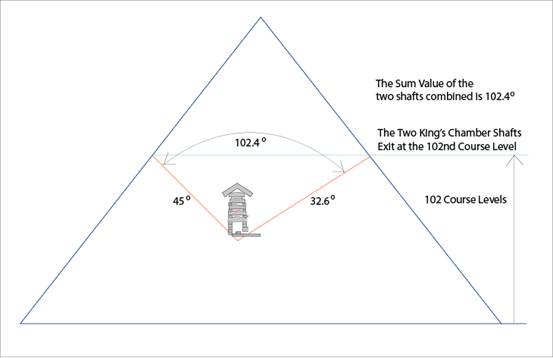
Figure 14 – Further Evidence that the number of Course Layers Reflect the Degree Values of the Angles Found within the GP.
We can certainly live with these more precise values as calculated by Spiros – as they work just as well. We are content that the angles from each of the three points and each to the centres of the two chambers are well within the correct "ball-park" – in that they do indeed correlate and present us with meaning.
Again, our main reason for using the values 23.5º, 6.5º and 11.75º in the main text is that it is a much quicker, simpler and neat way of getting the message of this discovery across to everyone who wishes to read about it.
In using the ideal values that relate to us today one would perhaps grasp the geophysical association immediately; and after days, weeks, months, even years of analysing everything we have found here, we feel justified in presenting this discovery in this way.
After all, if one plots the angles 23.5º, 6.5º and 11.75º then nevertheless one would discover that these angles fall well within the boundaries of the chambers and are only a fraction of a degree short of the distance from the centres of these chambers. And again, we would get more-or-less the same result if we were to plot the angles 23.98º, 6.02º and 11.99º (see fig. 15).
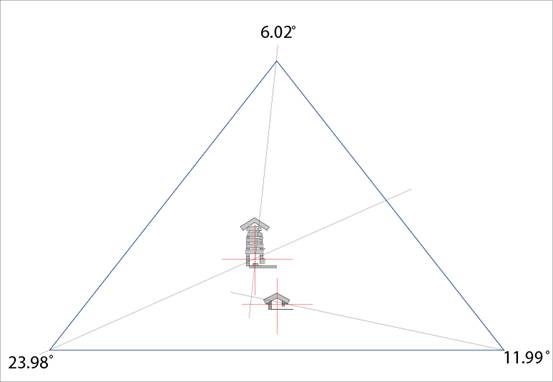
Figure 15 – The Angles of 23.98º, 6.02º and 11.99º still fall very close to the centres of the chambers – close enough to see that there is a clear geophysical connection here
Our point is that in using these approximate values and despite the 'obliquity time period' one is keeping to, one would still recognise the connection immediately and would still be able to match and superimpose the two diagrams – i.e., the Earth and the GP.
After this one would endeavour to obtain more precise values for these angles and would eventually get more-or-less the same results we are presenting here: but given the size of the Great Pyramid, and the enormous task and practical burdens the architects and builders had taken upon themselves to attain the level of perfection we are looking for, accepting these tiny discrepancies is not too difficult.
Of course for many these slight discrepancies would immediately be "jumped on" and used by those who could not and will not accept this discovery, as it violates everything we have learned about the pyramids and the people who built them.
Such people would argue against these findings; people who would readily dismiss any question of 'intent' on behalf of the architects – whom we are saying had purposefully planned the GP and its internal features around these geodetic-related angles.
But seriously, would anyone now question the intent of the architects to orient the Great Pyramid to the four points of the compass (its entrance face aligned with true north) because it is out by 3 arc minutes?
This is the point we are making here.
If even outside the boundaries of pyramidology, the above is not a theory, it is a major discovery . . . or rather a major 're-discovery'.
END.
The authors would like to express their thanks and appreciation to Spiros Boutsikos for providing the precise values of these angles to date based on his calculations of the Petrie measurements of the Great Pyramid of Giza.
Spiros' website: http://lexarithmos.net/




